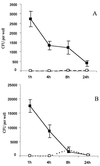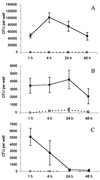Adherent invasive Escherichia coli strains from patients with Crohn's disease survive and replicate within macrophages without inducing host cell death
- PMID: 11500426
- PMCID: PMC98666
- DOI: 10.1128/IAI.69.9.5529-5537.2001
Adherent invasive Escherichia coli strains from patients with Crohn's disease survive and replicate within macrophages without inducing host cell death
Abstract
Escherichia coli strains recovered from Crohn's disease (CD) lesions are able to adhere to and invade cultured intestinal epithelial cells. We analyzed the behavior within macrophages of adherent invasive E. coli (AIEC) strains isolated from patients with CD. All the 15 AIEC strains tested were able to replicate extensively within J774-A1 cells: the numbers of intracellular bacteria increased 2.2- to 74.2-fold at 48 h over that at 1 h postinfection. By use of murine peritoneal macrophages and human monocyte-derived-macrophages, the reference AIEC strain LF82 was confirmed to be able to survive intracellularly. Transmission electron micrographs of AIEC LF82-infected macrophages showed that at 24 h postinfection, infected cells harbored large vacuoles containing numerous bacteria, as a result of the fusion of several vacuoles occurring after 8 h postinfection. No lactate dehydrogenase (LDH) release, no sign of DNA fragmentation or degradation, and no binding to fluorescein isothlocyanate-labeled annexin V were observed with LF82-infected J774-A1 cells, even after 24 h postinfection. LF82-infected J774-A1 cells secreted 2.7-fold more tumor necrosis factor alpha (TNF-alpha) than cells stimulated with 1 microg of lipopolysaccharide (LPS)/ml. No release of interleukin-1beta was observed with LPS-prestimulated J774-A1 cells infected with AIEC LF82. These findings showed that (i) AIEC strains are able to survive and to replicate within macrophages, (ii) AIEC LF82 replication does not induce any cell death of the infected cells, and (iii) LF82-infected J774-A1 cells release high levels of TNF-alpha. These properties could be related to some features of CD and particularly to granuloma formation, one of the hallmarks of CD lesions.
Figures





Similar articles
-
The Crohn's disease-associated adherent-invasive Escherichia coli strain LF82 replicates in mature phagolysosomes within J774 macrophages.Cell Microbiol. 2006 Mar;8(3):471-84. doi: 10.1111/j.1462-5822.2005.00639.x. Cell Microbiol. 2006. PMID: 16469058
-
Exosomes transfer miRNAs from cell-to-cell to inhibit autophagy during infection with Crohn's disease-associated adherent-invasive E. coli.Gut Microbes. 2020 Nov 1;11(6):1677-1694. doi: 10.1080/19490976.2020.1771985. Epub 2020 Jun 25. Gut Microbes. 2020. PMID: 32583714 Free PMC article.
-
Development of Heptylmannoside-Based Glycoconjugate Antiadhesive Compounds against Adherent-Invasive Escherichia coli Bacteria Associated with Crohn's Disease.mBio. 2015 Nov 17;6(6):e01298-15. doi: 10.1128/mBio.01298-15. mBio. 2015. PMID: 26578673 Free PMC article.
-
Adherent-invasive Escherichia coli: a putative new E. coli pathotype associated with Crohn's disease.Int J Med Microbiol. 2002 Sep;292(3-4):185-93. doi: 10.1078/1438-4221-00201. Int J Med Microbiol. 2002. PMID: 12398209 Review.
-
Adherent-invasive Escherichia coli in inflammatory bowel disease.Inflamm Bowel Dis. 2007 Oct;13(10):1277-83. doi: 10.1002/ibd.20176. Inflamm Bowel Dis. 2007. PMID: 17476674 Review.
Cited by
-
Intracellular colon cancer-associated Escherichia coli promote protumoral activities of human macrophages by inducing sustained COX-2 expression.Lab Invest. 2015 Mar;95(3):296-307. doi: 10.1038/labinvest.2014.161. Epub 2014 Dec 29. Lab Invest. 2015. PMID: 25545478
-
Crohn's disease as the intestinal manifestation of pan-lymphatic dysfunction: An exploratory proposal based on basic and clinical data.World J Gastroenterol. 2024 Jan 7;30(1):34-49. doi: 10.3748/wjg.v30.i1.34. World J Gastroenterol. 2024. PMID: 38293325 Free PMC article. Review.
-
The multifaceted virulence of adherent-invasive Escherichia coli.Gut Microbes. 2023 Jan-Dec;15(1):2172669. doi: 10.1080/19490976.2023.2172669. Gut Microbes. 2023. PMID: 36740845 Free PMC article. Review.
-
Adherent-invasive E. coli in Crohn disease: bacterial "agent provocateur".J Clin Invest. 2011 Mar;121(3):841-4. doi: 10.1172/JCI46333. Epub 2011 Feb 21. J Clin Invest. 2011. PMID: 21339637 Free PMC article.
-
Host engulfment pathway controls inflammation in inflammatory bowel disease.FEBS J. 2020 Sep;287(18):3967-3988. doi: 10.1111/febs.15236. Epub 2020 Feb 20. FEBS J. 2020. PMID: 32003126 Free PMC article.
References
-
- Aderem A, Underhill D M. Mechanisms of phagocytosis in macrophages. Annu Rev Immunol. 1999;17:593–623. - PubMed
-
- Baca O G, Li Y P, Kumar H. Survival of the Q fever agent Coxiella burnetii in the phagolysosome. Trends Microbiol. 1994;2:476–480. - PubMed
-
- Boudeau J, Barnich N, Darfeuille-Michaud A. Type 1 pili-mediated adherence of Escherichia coli strain LF82 isolated from Crohn's disease is involved in bacterial invasion of intestinal epithelial cells. Mol Microbiol. 2001;39:1272–1284. - PubMed
Publication types
MeSH terms
Substances
LinkOut - more resources
Full Text Sources
Other Literature Sources
Medical

